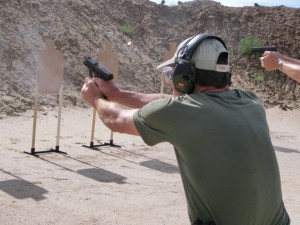The skills taught in professional defensive handgun classes sometimes surprise new students. There’s this tendency to think of it as a “shooting class,” and certainly marksmanship remains one of the building blocks to using a handgun for effective self defense.
But plain marksmanship, as important as it may be, isn’t the only skill taught in good classes. Defensive classes teach students to shoot within the larger context of self defense, which creates the need to cover a much wider and deeper set of skills than simply pulling the trigger.
In addition to simple shooting and smooth gunhandling, serious defensive handgun classes usually offer other important lessons, such as how to build a legally-defensible survival mindset or how to deal with the physical sensations of sudden stress. They might discuss the interpersonal skills that go with avoidance, de-escalation and deterrence. They may teach pre-incident threat management and what to do in the immediate aftermath of a shooting, or how to spot (and thus avoid) a predator looking for a fresh victim. They often teach crisis management and how to solve problems with the gun in hand. They might teach related physical skills, such as how to retain the handgun if the criminal tries to take it away, or what to do if you’re trying to draw the gun in very close quarters. They sometimes throw students into role-playing scenarios to force the students to put their own shooting skills into a realistic defensivce context.
In short, it’s a big field with a lot of closely-related subspecialties.
Well-rounded schools
To quote longtime defensive firearms trainer John Farnam, “The best schools are well-rounded. Our Art embraces an extensive repertoire of psycho-motor skills, verbal skills, and disengagement skills, along with a sound philosophical overlay, all of which must to carefully integrated. Some of the material is dry, but it is still important and must be included.” Farnam also notes that in his own gun courses, “we do a lot of shooting, of course. But, aggressive verbal and postural disengagement are also critical skills and must be learned and exercised in scenario-based drills every time we’re [on] the Range practicing our shooting skills. In this life, you’re going to talk with a lot more people than you’re going to shoot… with any luck!”
Farnam’s outlook is shared by other professional defensive firearm trainers. Almost universally, the pros regard the non-shooting portions of their programs to be at least as important as, or even more important than, pure shooting skills.
Where do you find them?
These necessary danger management skills may be taught, to one degree or another, in nearly all professional defensive firearms classes. But you certainly won’t find them in “this is the end the bullet comes out” classes intended for beginners, nor in pure shooting classes intended for competitive shooters. They only really show up in defensive firearms classes intended for ordinary citizens.[ref] The best value in such classes comes from trainers who deliberately and consciously avoid teaching from either a law enforcement or a military mindset, and instead focus on the tactics and survival rules an ordinary person should follow to tip their odds toward the best possible outcome. Even though many good instructors have such a background on their resume, that background should not form the mindset taught in class to non-LEO, non-military students. See Context Matters for more about that.[/ref]
Quite apart from any specific, individual skill they might learn, students walk out of this type of class with a firm understanding of what they don’t yet know and what they can’t yet do. That’s a tricky thing to teach (because confidence is a good thing), but it’s absolutely vital. The self-knowledge that says, “I’ve thought this through, and I’m willing to live with doing This but not That,” or that says, “I do not yet have the skills to do This, but I am able to do That” — that type of self knowledge can keep good people out of a world of hurt. It makes it less likely that you’ll jump into inappropriate situations, and more likely that you’ll survive when you fight back in appropriate ones.
But it all starts with understanding that defensive firearms skills are not the same thing as shooting cardboard targets at the range, not the same thing as playing fun and useful shooting sports games, not the same thing as imitating military and law enforcement tactics. Classes designed to teach defensive firearms skills might have some elements in common with any of those, but they also go far beyond that into life skills that aren’t offered in any of the other venues.





